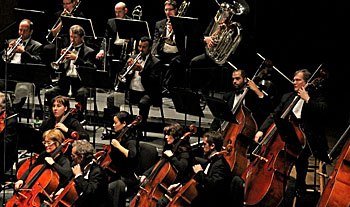Santa Cruz County Symphony Concert Review
On Sunday, March 23 at the Mello Center for the Performing Arts, the Santa Cruz County Symphony, under the new Music Director Daniel Stewart, presented a most delightful afternoon of beautifully performed music. The words written on the front page of the program “The future is now” are now lit in bright lights and deservedly so!
Bartok’s Dances consists of six dances that according to Bartok should not exceed four minutes to perform. Bartok seldom employed key signatures, however, editions today are available with them. Interesting to note that the main instruments used in this folk music are the fiddle (violin), clarinet, shepherd’s flute and cimbalom, instruments typical of the people of that Eastern European region.
The three languages of that area Slovak and Hungarian in particular and Rumanian in general are radically different in sound, but structured with an accent on the first syllable. This characteristic is reflected in Bartok’s compositions. Maestro Stewart understood and executed Bartok’s Dances in all authenticity and brought out impressive results. The articulated bowed/pizzicato accented, drone-like effect by the strings in several of the dances served as the backdrop against which solos by the clarinet, flute/piccolo and violin were performed with excellence. This work was well received by the audience.
Bach’s Orchestral Suite No. 2 immediately reflected an emotional solemnity that was woven throughout the six dances. Contrasting imitative Baroque textures were blended in the six dances that created a refreshing overall musical fabric. The many solos artistically performed by principal flautist Laurie Camphouse were superb.
The revolutionary Unanswered Question by Charles Ives is his most famous composition, an endeavor he called a “cosmic drama.” The work can be thought of as a triple layered collage scored for three groups: an on stage woodwind quartet, an off stage string ensemble that performs a dynamically quiet, hauntingly, penetrating choral that Ives said represented “the silence of the Druids” and a solo trumpet situated in the balcony of the Mello Center. At calculated intervals, Maestro Stewart cued the trumpet solo from the balcony that expressed an enigmatic phrase expressing “the perennial question of existence.” This question-answer idea continued by the trumpet answered by the woodwinds, each time somewhat more agitated and louder until the woodwinds simply stopped as the trumpet played the question one last time. Judging by the response of the audience, the Ives’ work was a most welcomed success into new, unchartered musical territory.
The orchestra paid keen attention to every nuance Stewart put forth in realizing the colorful orchestration Stravinsky employed in his Pulcinella Suite. The work proceeded with delicate dynamic balance, flawless phrasing and virtuosity throughout the entire concert by a list of all the wind, brass and string players! The long awaited interesting, intelligent programming the audience appreciated so much has finally arrived with much more to come. Bravo Maestro Stewart and Santa Cruz County Symphony!
